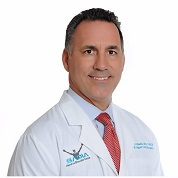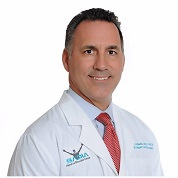
Dr. Alejandro Badia
Although calcific tendonitis is relatively common – as many as 10 percent of doctor visits for painful shoulder are due to this disorder – and oftentimes can resolve on its own, it is far from, being a benign disease.
MIAMI (PRWEB)
October 28, 2020
Mom always said, “Drink your milk; the calcium in it is good for you.” But that is certainly not the case if the calcium, vital to bone health, begins accumulating on muscles and tendons, especially causing unwanted crystal deposits on shoulder tendons, orthopedic surgeon Alejandro Badia MD, an expert in treating disorders of the upper limbs and author of the book Healthcare from the Trenches.
In fact, the condition – calcific shoulder tendonitis – can be severely painful, restrict shoulder movement and even lead to more serious complications, Dr. Badia states. He indicates that the calcium deposition is within the substance of the tendon, often related to ischemia, which can sometimes make it more challenging to remove. The disorder most commonly affects the supraspinatus tendon in more than 60 percent of the time.
The supraspinatus tendon is a strong, fibrous band of tissue that is part of the rotator cuff and extends along the top of the shoulder, connecting the upper arm bone (humerus) to the shoulder blade (scapula). It allows the arm to move laterally away from the body. Calcium can build up at various points along the tendon or spread out around it like peanut butter.
Although calcific tendonitis is relatively common – as many as 10 percent of doctor visits for painful shoulder are due to this disorder – and oftentimes can resolve on its own, “it is far from, being a benign disease,” says Dr. Badia, founder and chief medical officer of the Florida-based Badia Hand to Shoulder Center and OrthoNOW®.
He notes the latest study, appearing in the April 2020 edition of Arthroscopy, which indicates accumulation of calcium in the shoulder can increase a patient’s odds of experiencing a rotator cuff tear – a rip in the muscles and tendons that power the shoulder joint. The rotator cuff is what allows the shoulder joint to move and function properly and keeps the ball of the arm bone centered on the shoulder-blade socket during joint rotation.
The disorder can lead to other complications as well, including frozen shoulder, which develops when the connective tissue – or capsule – lining the shoulder cavity where the ball of the humerus fits into the shoulder blade socket becomes chronically inflamed, Dr. Badia says.
Specific causes of calcific tendonitis “remain a mystery.” Some experts blame fraying of the shoulder tendon fibers due to age and overuse – degenerative calcification — and say calcium deposits form as part of the healing process. However, evidence has not supported any direct relationship between the condition and individuals who do heavy work involving the upper limbs or in athletes active in overhead-related sports like tennis, Dr. Badia says.
Others refer to a host of underlying hereditary and medical issues, including a genetic predisposition for the disorder, abnormal thyroid gland activity, endocrine diseases like diabetes, changes at the cellular level, and hypoxia – deficiency in the amount of oxygen reaching the tissues.
What is known is that the condition usually develops between ages 40 and 60, predominantly affects women – about 70 percent of patients are female, and often results in stiffness of the shoulder, restricted joint motion and disabling pain. The pain is usually concentrated at either the front or back of the shoulder, may radiate down the arm and can get more acute at night. It often disrupts sleep and negatively impacts quality of life.
Formation of calcium deposits in the rotator cuff tendons is not unusual. Evidence suggests that as many 20 percent of the population have calcium present in the shoulder without symptoms. “Problems only develop when the patient begins suffering an inflammatory reaction to the calcium,” Dr. Badia says.
Oftentimes, the disorder will resolve itself on its own, but, until it does, doctors recommend nonoperative, conservative approaches as the first line of treatment to help patients manage the pain and related symptoms, Dr. Badia says. These therapies include heat and ice applications; use of non-steroidal, anti-inflammatory medications; and physiotherapy, which can involve a combination of massage, heat treatments and exercise.
For patients resistant to conservative measures, studies indicate that minimally invasive options, such as cortisone injections, ultrasound-guided needle lavage to aspirate the calcium deposits, and extracorporeal shock wave therapy to increase blood flow to the shoulder tissues, are usually effective. Dr. Badia notes that cortisone injects are now rarely recommended for calcific tendonitis because they can further weaken the tendon and in some cases prompt a rotator cuff tear. He adds that he prefers autologous plasma injections, such as PRP and an even more effective subset called Proteinase Inhibotors (PI). Moreover, Dr. Badia offers that the ultrasound-guided needle lavage called Tenex®, is a percutaneous (through small skin perforation) technique that liquifies and ablates the calcific deposit, then aspirating it out.
Only in a small percentage of cases – about 10 percent — is arthroscopic surgery required to remove the calcium crystals, Dr. Badia says. In these cases Dr. Badia ads that once the deposit is removed, he will also relieve any mechanical impingement on the cuff and then begin immediate motion of the shoulder, often with a continuous passive motion machine.
Much less clear than the treatments are the steps that can be taken to prevent calcific tendonitis since so little is known about its underlying causes. However, Dr. Badia recommends these tips to help ensure overall shoulder-joint health:
- Practice good nutrition. That means eat dark green leafy vegetables; fish; fruits, especially grapefruit; nuts (in small quantities); avocados; onions; and garlic.
- Warm up shoulder joints properly before engaging in intense exercises or sports.
- Minimize – or avoid – activities that place undue stress on shoulders.
- Use proper techniques when lifting heavy or cumbersome objects.
- Forget the “no pain, no gain” myth. Do not overdo work and other activities.
- Maintain a normal body weight and stop smoking.
“Most importantly, if your shoulder is sending you pain signals, pay attention to them. Contact an orthopedic specialist as soon as possible for evaluation,” Dr. Badia advises.
Bio: Alejandro Badia, MD, FACS, is an internationally renowned hand and upper-limb surgeon and founder of Badia Hand to Shoulder Center and OrthoNOW®, a network of walk-in orthopedic centers. Dr. Badia is the author of Healthcare from the Trenches. http://www.drbadia.com http://www.orthonowcare.com

